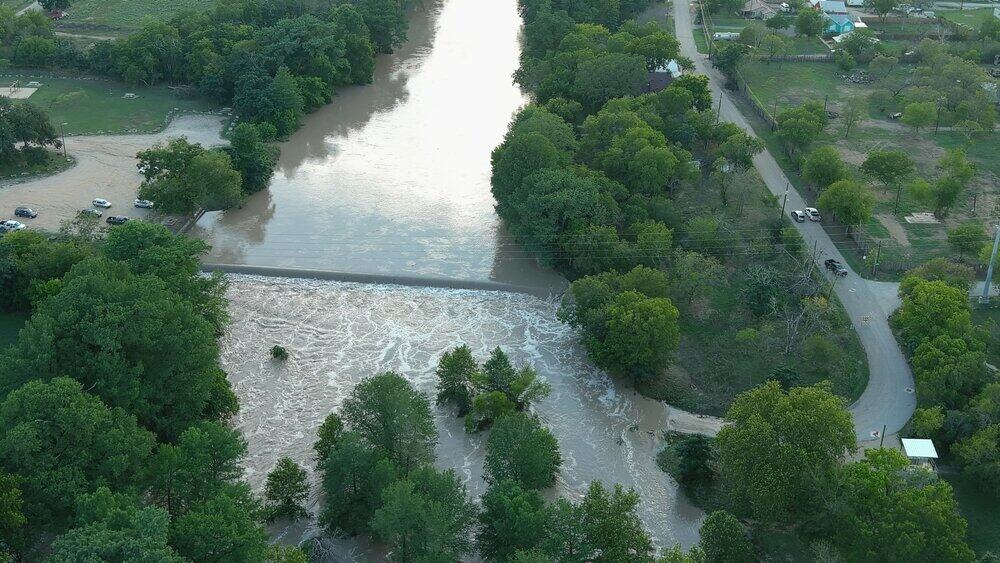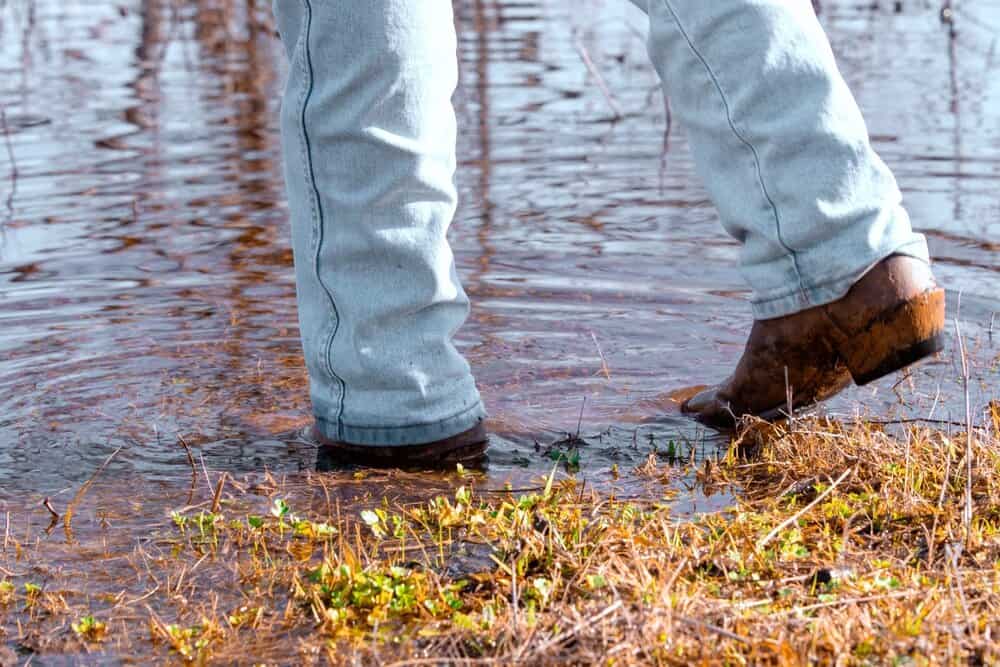Extreme Weather in Summer 2025: Natural Disaster Floods, Fires & More
by Brian O’Connell
Investigators are still combing the terrain in Kerr County, Texas, after massive flooding on July 4th resulted in at least 119 fatalities and 150 people still missing one week later. The floodwaters arrived at a time when low humidity, high temperatures, heavy rains, and dry riverbeds combined to create massive flash flooding, which didn’t come as a surprise to climate experts.

“Texas is particularly vulnerable, as is all too clear this week,” said Max Dugan-Knight, a climate data scientist at Deep Sky in Toronto, Canada. “The state of Texas has seen a 20% increase in the daily maximum rainfall over the past 40 years. In other words, extreme rainfall is happening more often, and it’s more severe when it does. Climate change has contributed to the extreme rainfall and flooding, wreaking havoc and claiming lives in Central Texas right now.”
Weather-related disasters are becoming all too common, particularly in the summer months when Mother Nature can become especially violent. Besides floods, hurricanes, tornadoes, and wildfires tend to increase in frequency during the summer months, highlighting the need for robust insurance strategies among households, businesses, and state and federal governments to mitigate weather-related disasters.
What weather-related insurance factors are particularly a priority? These issues rank highest.
What Weather Events Are Expected This Summer
As the Central Texas mass flood demonstrated, unforeseen disasters are a fact of life during summertime, with some weather eruptions more likely than others.
“This summer’s shaping up to be a rough one,” said Gregg Barrett, CEO at WaterStreet Company, a group of property/casualty insurance industry experts based in Kalispell, Montana. “The Atlantic Ocean is warm, so we’re most likely in for a busy hurricane season. The Gulf Coast is always in the spotlight, but I’d be especially mindful if I were in Texas. They’ve already had some devastating flooding, and if a slow-moving storm parks over them, it could get even worse.”

Out West, fires are expected to be a real problem as the weather heats up. “A lot of places had a good wet year that helped the vegetation grow, but now it’s all drying out,” Barrett said. “That turns into fuel. California’s at risk, parts of Arizona and New Mexico too.”
Tornadoes are expected to rise in the usual states, including Texas, Oklahoma, and Kansas. “The timing moves around some, but they’re always in play this time of year,” Barrett added.
In general, Barrett said his company expects storms to intensify more rapidly, fires to burn hotter in areas that have not experienced significant fires before, and flooding in neighborhoods that have never had a problem.
“Insurance companies look at the numbers,” he said. “When they see bigger losses and more frequent claims, they adjust, and prices increase.”
If you are impacted by a natural disaster in 2025, how does FEMA cuts or potential laws affect your insurance and the help you’ll receive? Learn about how the U.S. governments cuts to it’s disaster relief agency (FEMA) could impact homeowners and victims.
A Need for Robust Homeowners’ Insurance
Summer weather disasters couldn’t have come at a worse time, given the rising state of home insurance costs.
“Home insurance premiums have shot up 42% in fire-prone areas of California, and one in five homes in these areas has lost coverage since 2019. “The data shows clear market failure,” Dugan-Knight said. “There are now over 150,000 uninsured households in these areas in California alone.”
That’s a big problem, as extreme heat has a compounding impact with extreme weather like tropical storms. “Some people are killed not by the hurricane itself, but by the heat exposure following the loss of power and lack of air conditioning,” Dugan-Knight noted.
Start your summer home insurance review with solid flood insurance. “Most standard homeowner’s insurance excludes flood damage,” Dugan-Knight said. “Consequently, flood insurance should be a requirement for most, if not all, homeowners.”
That also applies to homeowners who may feel safe from flooding if they don’t live on the coast or if FEMA does not require them to have flood insurance. “Storms are travelling further inland, dropping more water than ever before in new areas,” Dugan-Knight added. Do not assume that previously safe areas are still secure. Furthermore, flood damage is usually costly. A single inch of water in an average-sized home can cause $25,000 of damage.”
State Insurance Update
In California, one in five homes in the most extreme fire-risk areas has lost coverage since 2019. “The state’s FAIR plan system is under extreme stress,” Dugan-Knight said. “California’s FAIR plan grew from insuring 210,000 homes in 2020 to over 463,000 in 2024, with total exposure exceeding $450 billion.”
According to California government data. The total figure paid out by insurance companies to cover losses from the LA fires may be as high as $44.5B USD, and the LA fires alone may consume over 40% of the FAIR plan’s annual resources, triggering emergency assessments on private insurers. “FAIR plans operate on thin margins and lack the capital reserves of traditional insurers,” Dugan-Knight added. “When catastrophic losses exceed FAIR plan resources, private insurers must cover the shortfall.”
Additionally, banks will not approve mortgages without home insurance, and few will buy a house without a mortgage (in a high-risk wildfire area, no less). “Without significant policy intervention, these properties will eventually become worthless,” Dugan-Knight said.
Adopt Preventive Weather Strategies
Homeowners shouldn’t stop at checking off the existence of a homeowners insurance policy; there’s more ground to cover.
For your house, check your policy as soon as possible,” Barrett advised. “Don’t wait for a storm. Trim your trees, secure anything that could fly around, and take photos of your stuff in case you need to file a claim.”
For your car, check that you have comprehensive coverage. “That’s what pays for storm damage,” Barett noted. “Plus, renters should remember the landlord’s policy doesn’t cover their stuff. You need your own renters’ insurance to replace your belongings if there’s a fire or storm.”
Travel Insurance Protection is Needed, Too
Travel insurance typically covers a wide range of scenarios that travelers want protection for, such as non-refundable trip investments, flight cancellations, medical emergencies, and other travel delays or cancellations.
Carol Mueller, vice president, strategic marketing and engagement at Berkshire Hathaway Travel Protection, advises travelers to take these insurance precautions.
Know the policy options. Before committing to a travel insurance plan, it’s important to fully understand the coverage it provides.
“Policies can vary depending on the plan type, so travelers should take the time to review the terms or consult with their travel insurance provider or travel advisor to select the plan that best suits the traveler’s needs,” Mueller said.
Purchase early for maximum protection. Travelers should purchase travel insurance as soon as they make their first nonrefundable payment for the trip. “That ensures maximum protection against cancellations or interruptions due to unforeseen circumstances,” Mueller noted.
Have a plan in case of disruptions. If something goes wrong, a savvy travel assistance team can make all the difference. “That plan should include 24/7 customer service to help travelers rebook flights, manage disruptions, and support travelers through unexpected events,” Mueller added. “Exclusions can differ from policy to policy, so it’s always best to read the policy details before purchasing.
For travelers seeking added flexibility and reassurance, consider a good ‘Cancel For Any Reason’ upgrade option, which offers the best policy features, allowing travelers to be reimbursed for up to 50% of nonrefundable trip expenses when canceling for reasons outside of standard covered events.
Businesses Need to Step Up Their Policies
U.S. businesses have a significant stake in protecting their assets from severe weather events, and for good reason, as they face increasing exposure to both acute and chronic weather and climate risks. “Acute risks include sudden events like hurricanes or flash floods, while chronic risks involve long-term shifts such as rising sea levels or prolonged droughts,” said Lars Regner, head of resilience services at HDI Global, a corporate and specialty insurance company. “For example, NOAA data shows that the U.S. experienced 28 separate billion-dollar weather and climate disasters in 2023 alone, more than double the annual average from the previous decade.”
These events don’t just damage property, they disrupt operations, displace workforces, and strain supply chains. “Beyond the immediate impact, there are second-order effects: water scarcity affecting cooling systems, or thawing permafrost compromising infrastructure in northern regions,” Regner noted.
Companies like HDI are leveraging science-based climate models, which will allow insurers to anticipate threats and risks with increasing precision. “We’re using multi-scenario modeling to assess how risks evolve over time, thus helping clients identify vulnerabilities and implement mitigation strategies,” Regner said. “This includes everything from flood defenses and heat-resilient infrastructure to business continuity planning.”
Technologies like artificial intelligence and data modeling can help mitigate or even eliminate hidden costs beyond just property damage when weather incidents occur.
“We refer to these as ‘second-order risks,’ which are risks that develop slowly or are often overlooked,” Regner said. “For example, immediate concerns are when workers need to evacuate the area due to a flood or wildfire and work stops, or companies need to use more power/energy than usual to protect assets during a heat wave.”
Businesses also face acute risk versus chronic risk to consider.
“Acute physical risks refer to those that are event-driven, including increased severity of extreme weather events, such as cyclones, hurricanes, or floods,” Regner said. “Chronic physical risks refer to longer-term shifts in climate patterns (e.g., sustained higher temperatures) that may cause sea level rise or chronic heat waves.”
Regner advises using an insurance carrier that will consult with you over time as climate change risk becomes more prevalent, on how to adapt your business to ensure it stands the test of time.
“In today’s climate, robust insurance, including property, business interruption, and liability, is not just a safeguard; it’s an essential part of any business resilience strategy,” he said.
Looking Ahead
If there are two certainties in the insurance sector, rising costs and continued weather threats would likely lead the list.
Insurance premiums will keep going up, there’s just no way around it,” said Jordan Blake, director of communications and operations at Shoreline Public Adjusters, LLC. “The cost to rebuild is higher, reinsurance markets are tighter, and weather events are more severe.”
All of that adds up to higher risk for the insurance sector and its customers.
“When risk goes up, so do prices,” Blake said. “It’s already happening.”
